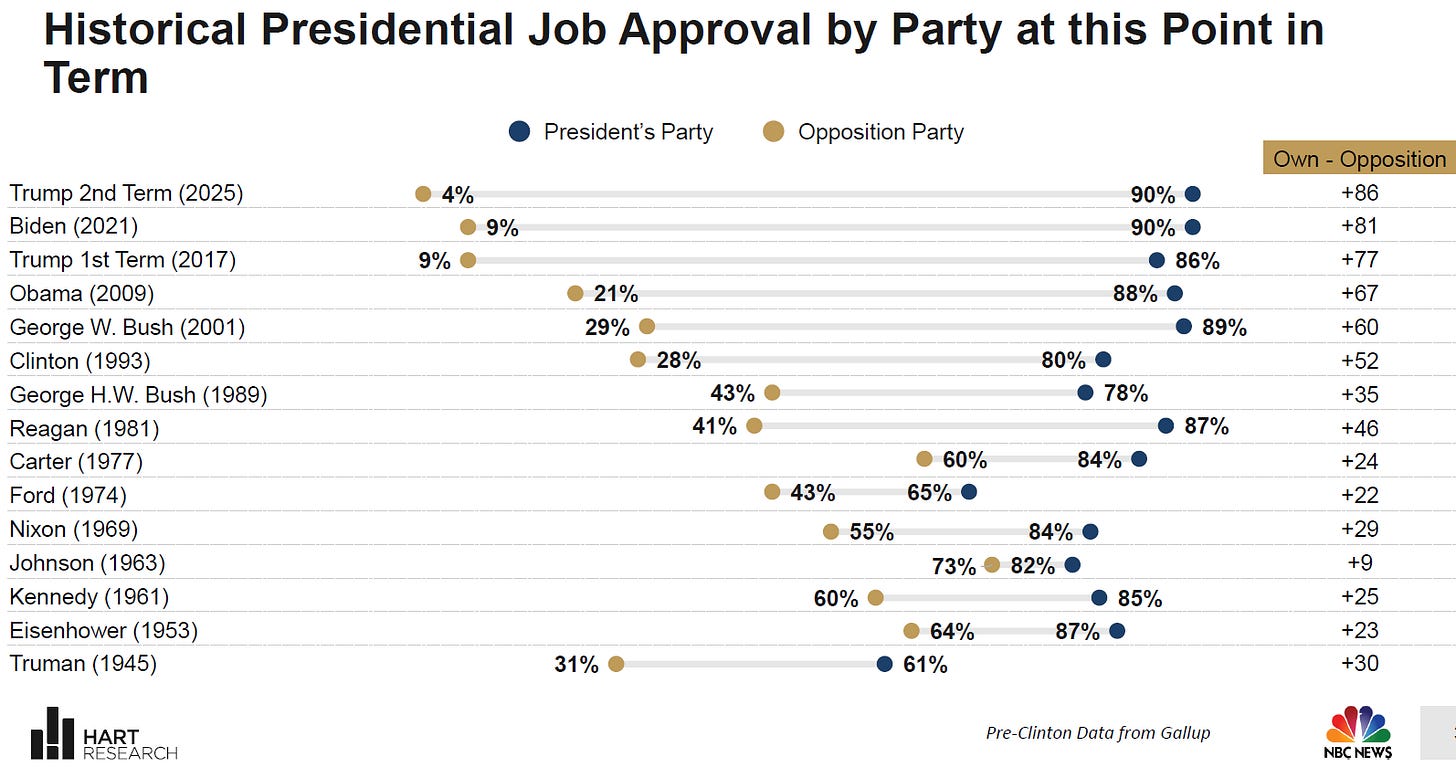Six-Chart Sunday – Where You Sit Is Where You Stand
6 Infographics + 1 Video (Justin Hardy -- Mind Over Matter)
The most interesting part of the “First Hundred Days” coverage was the vast divergence in perspective among voters. Democrats think the first hundred days were a disaster & the Trump Administration is failing. Republicans think the first hundred days were successful & the best is yet to come. As with so much of modern politics, where you stand depends on where you sit.
The partisan approval gap persists and grows. 90% of Republicans approved of President Trump’s job performance mid-April (~85 days in), tied for the highest own party approval at this point in the term per Hart Research. (Yes, there is growing evidence of slippage among Republicans in the subsequent 15 days as “Liberation Day tariffs” increased market fear & volatility).
There’s a massive partisan divide in confidence in the Administration moving forward. Republicans continue to trust President Trump’s ability to successfully do his job, while Democrats have almost no confidence at all.
Are polls really more than just partisan ID tests? Partisanship often renders polling results, even about the economy, more of an exercise in partisan loyalty than perceived reality. The Michigan Consumer Sentiment Index has long shown a partisanship gap and it’s growing: from ~27% during the second Bush & both Obama terms, to 54% across Trump 1, 72% during Biden’s four years and now 88% in Trump 2 (that is, own-party voters are almost twice as likely to express economic optimism as other-party voters).
Much partisan difference in approval of / confidence in presidents results from getting news from different sources. Voters from the two major parties often lack a shared reality. We get very different news from very different sources, as networks such as Fox & MSNBC convey significantly divergent facts.
We wildly mis-estimate the views of those in the other party. As a result of partisan media, online echo-chambers, and demagogic politicians in both parties, we have very inaccurate understandings of the viewpoints of those on the other side. (I loved this Perceptions Gap poll from 2019, and wonder where the data are now, after the COVID years. Also note the question on the police is poorly phrased, with “(disagree)” easy to miss).
So what? Takeaways for analysts and advocates:
— Analysts need to resist personal bias in their assessments. Trump detractors may mistakenly think that the President shares their conviction that he’s failing (he doesn’t) and give up on policies they don’t like (he won’t). Supporters may mistake objective market signals for partisan criticism, missing critical signals amidst the noise.
—For advocates, the only way to overcome prejudiced presumptions inflamed by partisan media is to show up and make your case… in person. All trust is local.
VIDEO
Justin Hardy’s Story: Mind Over Matter. Justin Hardy was the 2nd leading scorer on the nationally-ranked Washington University Division III basketball team, a feat made more impressive by the fact he did it while fighting for his life with Stage 4 stomach cancer.











Great post as usual Bruce. Quick question on #6: do you have recent, specific data about trust in big business vs. my employer?
Great material as always Bruce. I wish the media source polling asked for the "major" source of news instead of Major/minor source. My experience is the Trump supporters rely almost solely on FOX and similar sources so the information they have is very different from voters who read and watch widely. When major/minor is used I think there is socially desirable response bias.